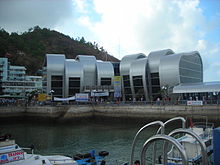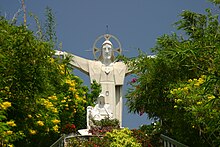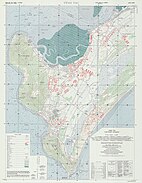Vũng Tàu
You can help expand this article with text translated from the corresponding article in Vietnamese. (March 2024) Click [show] for important translation instructions.
|
Vũng Tàu
Thành phố Vũng Tàu | |
|---|---|
Clockwise from top: Front Beach skyline, Thích Ca Phật Đài, Bạch Dinh (vi), Christ of Vũng Tàu, Long Sơn Mansion (vi) | |
 Map of central Vũng Tàu | |
| Coordinates: 10°23′N 107°7′E / 10.383°N 107.117°E | |
| Country | |
| Province | Bà Rịa–Vũng Tàu province |
| Government | |
| • Secretary of CPV | Trần Đình Khoa |
| • Chairman of People's Council | Lê Thị Thanh Bình |
| • Chairman of People's Committee | Hoàng Vũ Thảnh |
| Area | |
| • Land | 141.1 km2 (54.5 sq mi) |
| Population (2023)[1] | |
| • City | 454,288 |
| • Urban | 341,552 (96%) |
| • Ethnicities |
|
UTC+7 (Indochina Time) | |
Vũng Tàu (Hanoi accent:
Administrative divisions
Since April 2015, Vũng Tàu consists of 16 wards (phường):
.The wards are divided into quarters (khu phố), which are divided into smaller groups (tổ dân phố). The commune is divided into hamlets (thôn).
History



According to archeological excavations in 2002 and
Between
In 1295, Zhou Daguan (Chinese: 周達觀), a Yuan Chinese diplomat serving under Temur Khan, passed by Vũng Tàu on his official voyage to Angkor, Chenla. In his book The Customs of Cambodia (Chinese: 真臘風土記; pinyin: Zhēnlà Fēngtǔ Jì, literally Chenla Culture and Land Report) referred to Vũng Tàu as Zhenpu 真蒲, which he described as the border of Chenla.
自溫州開洋,行丁未針。歷閩、廣海外諸州港口,過七洲洋,經交趾洋到占城。又自占城順風可半月到真蒲,乃其境也。[4] Since departing from Wenzhou, it has not done anything yet. It traveled through the ports of Fujian and Guangzhou, crossed the Qizhou Sea, and reached Champa via the Jiaozhi Sea. Moreover, if the wind blows from Champa, you can reach Zhenpu in half a month, which is its territory.
During 14th and 15th centuries, the cape that would become Vũng Tàu was a swamp which European trading ships visited regularly. The ships' activities inspired the name Vũng Tàu, which means "anchorage". The Portuguese referred to this place as Oporto Cinco Chagas or simply Cinco Chagas in their maps. Apres de Mannevillette (1707–1780), one of the greatest French chart-publishers, mentioned Saint Jacques in his book La Neptune Oriental. This term was later adopted by Europeans and the French.

The French Indochinese government later named it Cap Saint-Jacques (Cap Xanh Giac, in Vietnamese). The cliff of Vũng Tàu is now called Mũi Nghinh Phong (literally meaning "Cape of breeze welcome" or "Cape of greeting the wind").
Vietnamese settlement
During the 16th and 17th century, conflicts caused by the opposing clans in the Trịnh–Nguyễn War led to emigrations of Vietnamese people from Thuận Quảng to the coastal area near Vũng Tàu.[5]
Vũng Tàu was originally referred to as Tam Thắng (“Three Boats”) in memory of the first three villages in this area: Thắng Nhất, Thắng Nhị, Thắng Tam, within the province of
The kings Gia Long, Minh Mạng and Thiệu Trị invested heavily into Vũng Tàu's protection, by opening various defensive facilities. A military barrack, Phước Thắng bảo 福胜保, on the hill slope overlooking the Buffalo Cape, then called was built in 1839. The barrack was operated as a fortress and armed with 6 bronze cannons[6]
French colonisation
10 February 1859 marked the first use of cannons by Nguyễn's army, when they fired at French battleships from the fortress of Phước Thắng, located 100m from Vũng Tàu's Front Beach. This marked an important period in Vietnam's war against French invaders in southern Vietnam (then called Cochinchina).
In
On 1 May 1895, the governor of Cochinchina established by decree that Cap Saint Jacques would thereafter be an autonomous town. In 1898, Cap Saint Jacques was merged with Bà Rịa county once again, but re-divided in 1899. In 1901, the population of Vũng Tàu was 5,690, of which 2,000 persons were immigrants from northern Vietnam. Most of the town's population made their living in the fishing, farming and service industries. On 4 April 1905, Cap Saint Jacques was made an administrative district of Bà Rịa province. In 1929, Cap Saint Jacques became a province, and in 1934 became a city (
Between 1885 and 1934 period, the French designed the town centre along the Front Beach, then named Baie de Cocotiers, along with several notable architectural works for the administrative function such as l'Hôtel de l'Inpsection, the Post Office, Grand Hotel and the Lighthouse.[8] In 1898, the French governor of Indochina, Paul Doumer (who later became president of France), built the Villa Blanche in Vũng Tàu that is still a prominent landmark.
A national route was paved in 1896 (then called Colonial route 15), as well as a jetty in the Front Beach to connect Cap with Saigon.
In the First Indochina War Vũng Tàu's military hospital facility was used by French soldiers on sick leave.
On 21 July 1952 Viet Minh fighters disguising themselves in French military uniforms and armed with machetes, grenades, and Sten submachine guns snuck into the building's R&R centre, where a number of unarmed French officers were having dinner with their families. The rebels threw a grenade from the kitchen killing the Vietnamese bartender, then shot the cook Nguyen Van Loc who was trying to play dead. Attackers stationed in the hallway found the four children of Air Vietnam President Jean Perrin-Christian, Elysabeth, Michel, and Nicole- who were playing a game of hide-and-seek. Elysabeth, Christian and Nicole were gunned down by the Viet Minh, and Michel who tried to run away was hacked to death with machetes. Now that the coast was clear they entered the dining room where the French customers were attacked with gunfire and grenade attacks. Twenty people including four Vietnamese civilians were killed in the attack, and 23 were injured. The only people to survive unharmed were a boy who hid behind a chair and a lieutenant who covered himself in a dead woman's blood to make it appear he was dead.[9][10][11]
South Vietnam

After the
With a strategic location right at the sea route close to the capital city of Saigon, the government of the Republic of Vietnam and its allies in the United States, Australia, and South Korea consolidated and developed Vung Tau into a strategic defense spot. After taking over French military facilities here, the Army of the Republic of Vietnam established many large training facilities such as the Training Center for Rural Construction Officers, the Communications School, and the Military Police School, Cade School and Military Hospital.
During the
Due to its rising significance as a military base and coastal beach resort, Vung Tau attracted a large number of residents during the war time. Its population rose from 29,390 in 1955 to a whopping 119,300 in 1973.[13]
The fall of Vũng Tàu
In the last days of April 1975, many South Vietnamese troops retreated to Vũng Tàu as the communists closed on southern Vietnam. After the capture of Bà Rịa and Phước Tuy Province on 27 April, the 3rd NVA Division forces began their attacks on Vũng Tàu. However, the Cỏ May bridge had been destroyed, and strong defense from ARVN Airborne at the south end of the bridge proved fatal to the northern forces. The Division's 12th Regiment was then landed by fishing boats behind the Airborne lines and this, together with a renewed attack by the 2nd Regiment, forced the Airborne to retreat into Vũng Tàu. At 01:30 on 30 April the Division began its attack on Vũng Tàu forcing the Airborne into the city center where they eventually succumbed at 11:00.[14]:chapter 6 [15]: 476 [16] A fierce armed hostage crisis took place between the ARVN officers and the communists at Palace Hotel ended with the final surrender at 13:30.
After the
After the war, due to Vietnam being put under debilitating trade embargoes by the United States and failing economy, Vũng Tàu was a common launching place for the "Vietnamese boat people" – refugees escaping the post-war Communist regime.
Special zone
After oil was discovered in southern Vietnamese waters, the Vietnamese government pushed for the exploitation and extraction of this new resource. On 30 May 1979, Vũng Tàu was merged with Côn Đảo Islands to form Vũng Tàu-Côn Đảo Special Zone in a bid to facilitate the new service and logistics hub for the oil industry. Between 1980 and 1982, the city saw drastic changes in infrastructure and demographically was transformed into a service and logistics hub for the new industry. Politically, the Special zone was given the same status as provinces and centrally-run cities. Administratively, it was divided into 1 district (Côn Đảo) and 5 wards: Châu Thành, Thắng Nhất, Thắng Nhì, Thắng Tam, Phước Thắng and Long Sơn commune.
The central government assigned nearly 10,000 officers and professional engineers from many non-business units, industries, construction and the military. A seaport logistics service area serving the import and export of technical materials and petroleum products was established in a swamp area along the shore of Ganh Rai Bay.
After the signing of Soviet-Vietnam agreement on oil exploitation and establishment of Vietsovpetro, the city welcomed more than 2,000 Soviet officials and experts to work in the joint venture. In order to create comfortable accommodation for the new workers, in 1985 the special zone government and the General Department of Petroleum built a separate dormitory for these people, often called the "5-storey area".[17] Currently, this apartment complex still has more than 520 households with about 1,000 Russians living and working.
Provincial city
On 12 August 1991, the Special Zone was dissolved by a governmental decree. Bà Rịa–Vũng Tàu province was officially created from this former zone and nearby districts of Đồng Nai Province. Vũng Tàu once again was re-established as a thành phố (city).[18]
Success from Đổi mới and profits from seafood and petroleum exports brought a large budget source to Ba Ria-Vung Tau province, creating positive changes to repel the socio-economic crisis. The production value of economic sectors across the city only reached 271 billion VND at the time of establishment, by 2021, it reached 70,500 billion VND (260 times than the origin).[19]
The tourism and industrial production sectors began to thrive. In 1996, the city inaugurated Dong Xuyen Industrial Park.
In the late 1990s and 2000s, the city carried out a spectacular transformation with the construction and improvement of inner city roads, and the expansion of many key projects such as Le Hong Phong Road, Martyrs Memorial and Nga Nam roundabout. Ba Thang Hai Road (National Highway 51C) was also built and inaugurated during this period, replacing 30 Thang 4 (National Highway 51A) as the main road leading into the centre. As of 2023, 100% of roads and alleys were paved and solidified.[20] The openings of Gò Găng and Cửa Lấp bridges helped connect Vũng Tàu with nearby districts faster.
Numerous commercial and urban developmental projects were established during the 2000s such as Vung Tau City Commercial Centre, Chi Linh Urban Area, Dai An Urban Area and A Chau Urban Area.
In 2012, the provincial administrative centre moved to Bà Rịa.
Economy and tourism
Shipping and oil exploration
The city is located in the south of Vietnam, situated at the tip of a small
Industry
PEB Steel operates several factories in Vũng Tàu.[22][23]
Beaches
Vũng Tàu has 4 extensive beaches, including Back Beach (Bãi Sau), Front Beach (Bãi Trước), Strawberry Beach (Bãi Dâu), Pineapple Beach (Bãi Dứa).
Resorts and theme parks
A big resort project has just been licensed by the Vietnamese government, the Saigon Atlantis. Upon completion, this entertainment project worth US$300 million in capital investment will include resorts, shopping and sailing.[24] The investor of this project is proposing to raise the investment capital to US$4 billion. Two other noteworthy entertainment projects awaiting licensing are Vũng Tàu Aquarium, which will cost US$250 million, and Bàu Trũng, a Disneyland-like entertainment park which will cost US$250 million. The project includes Landmark Tower, an 88-story skyscraper proposed to be built and completed by 2010 in Vũng Tàu by a USA-based company, Good Choice Import – Export Investment Inc, once built will likely be the highest building in Vietnam. The project is under consideration for approval by the local provincial government.[25][26]
Culture
Holidays and festivals
In Vũng Tàu, one of the most widely celebrated holidays is Lễ hội Cá Ông (Whale Holiday). Festivals in the region include the
Religion
As in most provinces and cities in Vietnam, Buddhism is the predominant religion.
Before the area was settled by ethnic Vietnamese, the Khmer people practiced
There has been a Russian village in Vũng Tàu ever since the Soviet era; these Russians generally worked for the Russian-Vietnamese joint venture VietSovpetro. It is believed that these "Russians", or "citizens of the former Soviet Union", were once the most dominant group of foreigners in Vũng Tàu. Some have remained in Vũng Tàu after the dissolution of the Soviet Union. They formed a parish of the Russian Orthodox Church. [citation needed]
One of the Vietnamese whale worship sites, the Lăng Ông Nam Hải Whale Temple, hosts a skeleton of a whale, being respected in the name of Nam Hai General, a whale god. Nam Hai General is said to govern the ocean and protect people from evils, monsters, and disasters, and an annual festival is held in recognition.
Cuisine
This section needs expansion. You can help by adding to it. (April 2020) |

Bánh khọt are small round savoury pancakes. Vung Tau has its own variety that is more crispy and has shrimp added on top.[31]
Bánh xèo Vũng Tàu are pancakes famous for its taste which cannot be found in anywhere. Ingredients include rice flour, shrimp, pork, bean sprouts but it tastes is more significant thanks to the crust made from fresh chicken eggs, and the filling full of onions and mushrooms.[32]
Climate
| Climate data for Vũng Tàu | |||||||||||||
|---|---|---|---|---|---|---|---|---|---|---|---|---|---|
| Month | Jan | Feb | Mar | Apr | May | Jun | Jul | Aug | Sep | Oct | Nov | Dec | Year |
| Record high °C (°F) | 32.9 (91.2) |
35.8 (96.4) |
34.8 (94.6) |
36.5 (97.7) |
36.7 (98.1) |
36.4 (97.5) |
34.6 (94.3) |
35.3 (95.5) |
35.7 (96.3) |
34.7 (94.5) |
34.0 (93.2) |
34.7 (94.5) |
36.7 (98.1) |
| Mean daily maximum °C (°F) | 29.3 (84.7) |
29.6 (85.3) |
30.6 (87.1) |
32.0 (89.6) |
32.4 (90.3) |
31.8 (89.2) |
31.2 (88.2) |
31.1 (88.0) |
31.0 (87.8) |
30.7 (87.3) |
30.6 (87.1) |
29.8 (85.6) |
30.9 (87.6) |
| Daily mean °C (°F) | 25.3 (77.5) |
25.7 (78.3) |
27.0 (80.6) |
28.5 (83.3) |
28.8 (83.8) |
28.0 (82.4) |
27.4 (81.3) |
27.3 (81.1) |
27.2 (81.0) |
27.0 (80.6) |
26.8 (80.2) |
25.8 (78.4) |
27.1 (80.8) |
| Mean daily minimum °C (°F) | 23.1 (73.6) |
23.9 (75.0) |
25.5 (77.9) |
26.8 (80.2) |
26.6 (79.9) |
25.8 (78.4) |
25.3 (77.5) |
25.4 (77.7) |
25.2 (77.4) |
25.0 (77.0) |
24.7 (76.5) |
23.6 (74.5) |
25.1 (77.2) |
| Record low °C (°F) | 16.8 (62.2) |
18.0 (64.4) |
19.5 (67.1) |
19.7 (67.5) |
18.7 (65.7) |
17.9 (64.2) |
17.5 (63.5) |
18.2 (64.8) |
18.6 (65.5) |
18.7 (65.7) |
17.0 (62.6) |
15.0 (59.0) |
15.0 (59.0) |
| Average rainfall mm (inches) | 4.3 (0.17) |
1.1 (0.04) |
5.2 (0.20) |
34.0 (1.34) |
181.7 (7.15) |
223.8 (8.81) |
225.0 (8.86) |
206.0 (8.11) |
218.5 (8.60) |
239.5 (9.43) |
63.6 (2.50) |
16.4 (0.65) |
1,418.9 (55.86) |
| Average rainy days | 1.0 | 0.4 | 1.0 | 3.7 | 14.3 | 18.7 | 19.9 | 18.7 | 18.4 | 16.9 | 6.8 | 3.5 | 120.8 |
| Average relative humidity (%)
|
77.2 | 77.4 | 77.2 | 76.9 | 79.1 | 81.7 | 82.8 | 83.3 | 83.7 | 84.0 | 81.0 | 78.7 | 80.3 |
| Mean monthly sunshine hours | 240.7 | 250.8 | 285.6 | 271.7 | 229.2 | 192.4 | 205.8 | 195.7 | 183.7 | 188.7 | 202.9 | 204.5 | 2,643.3 |
| Source 1: Vietnam Institute for Building Science and Technology[33] | |||||||||||||
| Source 2: The Yearbook of Indochina [34] | |||||||||||||
Transport
From Hồ Chí Minh City, it takes about two hours to reach Vũng Tàu by road (51A Expressway), and two and a half hours by high speed ferry,[35] or one and a half hours by car on the freeway.









